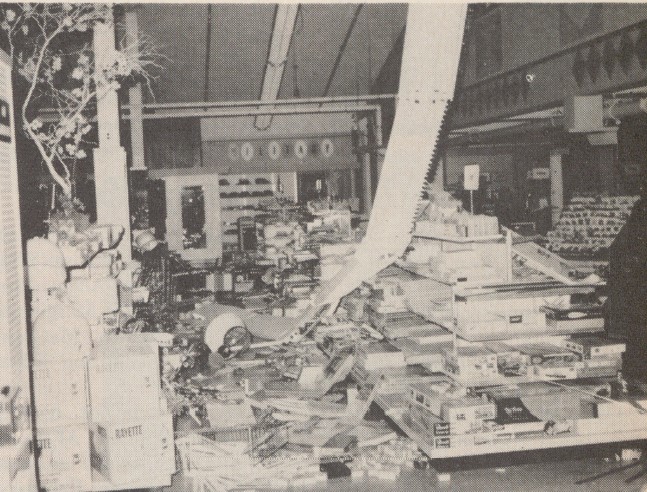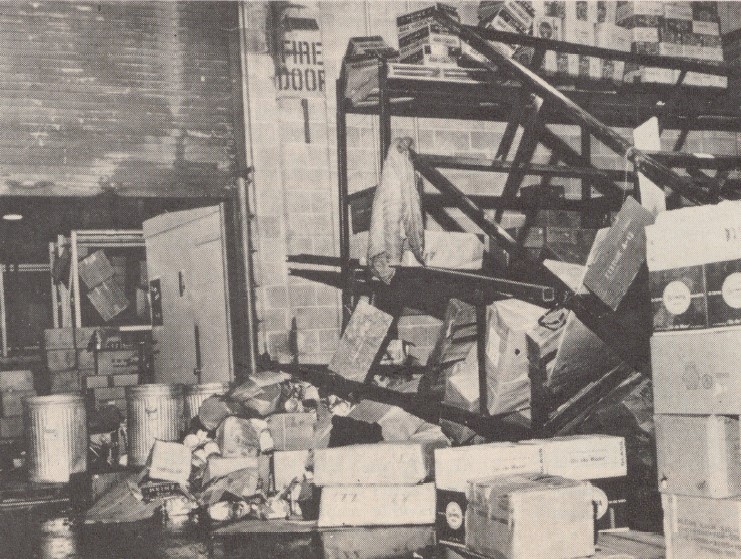#FlashbackFriday: A Tale of Two Earthquakes—1957 and 1964

Late March brings the anniversaries of two earthquakes that affected Exchange facilities—one 68 years ago and the other 61 years ago. The first one was relatively innocuous; the second one was much worse.
The first one occurred March 22, 1957. The Daly City earthquake, named for a San Francisco-area town, registered at 5.3 on the Richter scale and was the strongest quake to hit the Bay Area since the catastrophic San Francisco quake of 1906. One person was killed, dozens were injured and damage was heavy from not only the quake but a series of aftershocks.
According to an April 1957 Exchange Post article, “The San Francisco Regional Office and Bay Area exchanges conducted ‘business as usual’ … although the area continued to quiver occasionally from aftershocks.
Damage to the regional office was limited to one small piece of plaster that fell from the ceiling. No Exchange associates were injured. Associates were permitted to leave their jobs early, but most calmly kept working on-site.

Merchandise litters the floor at Stillwell Hall Branch No. 7 after a March 22, 1957, earthquake in California.
In a May 1957 Exchange Post story, associates recounted what they earthquake was like for them. One’s apartment was destroyed by a flash fire and explosion that occurred during a March 23 aftershock. Although she lost her apartment, she happened to be staying with friends at the time and escaped harm when the explosion happened.
Another associate was hospitalized for shock. A snack bar associate at Crissy Field, near the Golden Gate Bridge, was waiting on customers when the quake hit. “The crowd started running out,” she told the Exchange Post. “I ran too, but got as far as the door when I realized I had left all the money in the register, and dashed back to my post. By that time, the shaking was over and we were none the worse off as no one was hurt and no damage done. The aftereffects had us all rather jumpy.”
George G. Elliott, the Bay Area general manager, said that the quake knocked several trophies and ceramics at his house to the floor, where they shattered, and that it also emptied his medicine cabinets. “Now they tell me my home is situated right over the San Andreas Fault!” he told the Exchange Post. “As for me, trying to review a budget and operational results from underneath my desk had its disadvantages.”
The other late-March quake happened March 27, 1964, in Anchorage, Alaska. Measuring at 9.2 on the Richter scale, it’s the strongest earthquake on record to hit the United States.
The Elmendorf AFB main store, a $100,000 facility, happened to open the day before the quake hit. Five minutes after the quake struck, smashed merchandise filled the aisles, but structural damage was limited to ceiling fixtures. Although customers and associates were in the store when the quake hit, no one was injured; the store manager and the assistant manager, who were in the office on the mezzanine, crawled down stairs to the main floor, avoiding crashing file cabinets. When they got to the main floor, they were the only people left in the Exchange.

Smashed merchandise filled the aisles at the Elmendorf AFB Exchange, which had opened a day before a 9.2-magnitude earthquake struck the Anchorage, Alaska, area on March 27, 1964.
In one branch of the ALCOM Exchange, which had headquarters at Elmendorf, cash registers tumbled to the floor and jammed shut. In another, a safe was buried under cases and fallen shelving. Many in the area went without heat for nearly 24 hours, on a night when the temperature dropped to about 2 degrees Fahrenheit.
“Through the night and early next morning, the ALCOM Exchange filled emergency requirements for the base hospital, where all patients had been evacuated to a smaller building housing the nurses’ quarters,” the Exchange Post reported in a May 1964 story. “[Hospital officials] were asking for flashlights and batteries, baby bottles, electric lamps and disposable diapers.”
At Fort Richardson, where damage was less severe than at Elmendorf, the main Exchange and cafeteria were serving customers by 10 the next morning. At Elmendorf, with the main Exchange out of commission, an all-out effort ensued to get three Exchange ”groceterias” (primarily food stores but with additional merchandise such as over-the-counter medicine) into operation to provide customers with essential items.
Lines began to form early, with customers asking for batteries, camp stoves, fuel, candles and more. All three groceterias opened by 10:30 a.m. and were able to fulfill the requests.
The main warehouse, containing more than $2 million in merchandise—the equivalent of more than $20 million today–was severely damaged.
After the earthquake, which occurred on Good Friday, associates worked strenuously through the weekend, and by Monday morning the ALCOM Exchange was able to report all activities back in operation. except for several small branches and snack bars in buildings so damaged that even clean-up crews were not allowed. A week later, the Exchange had returned to near-normal operation, earning praise from Col. Victor Nielsen, the ALCOM Exchange officer.

Damage at the Elmendorf AFB Exchange warehouse after a 9.2-magnitute earthquake shook Alaska on March 27, 1964.





Not mentioning of March 11, 2011, when a 9.1 magnitude earthquake hit in Tohoku followed by the Tsunami. 20 thousand lives were lost. Misawa got shaken up pretty good and still snow on the ground and no power or heat no cell phones. AAFES had blackberry communication reporting to HQ of the impact. I will never forget that day.
Thanks, Erika. That earthquake was covered in a previous Flashback Friday: #FlashbackFriday: How Japan Stores, Bakery ‘Got It Done’ After 2011 Earthquake
Robert Philpot
The Exchange Post